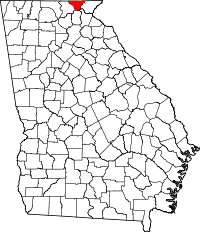Young Harris, Georgia
| Young Harris, Georgia | |
|---|---|
| City | |
|
Georgia State Route 2 in Young Harris | |
 Location in Towns County and the state of Georgia | |
| Coordinates: 34°56′3″N 83°50′52″W / 34.93417°N 83.84778°WCoordinates: 34°56′3″N 83°50′52″W / 34.93417°N 83.84778°W | |
| Country | United States |
| State | Georgia |
| County | Towns |
| Area | |
| • Total | 1 sq mi (2.6 km2) |
| • Land | 1 sq mi (2.6 km2) |
| • Water | 0 sq mi (0 km2) |
| Elevation | 1,923 ft (586 m) |
| Population (2010) | |
| • Total | 899 |
| • Estimate (2016)[1] | 1,431 |
| • Density | 602/sq mi (232.3/km2) |
| Time zone | Eastern (EST) (UTC-5) |
| • Summer (DST) | EDT (UTC-4) |
| ZIP code | 30582 |
| Area code(s) | 706 |
| FIPS code | 13-84960[2] |
| GNIS feature ID | 0356657[3] |
Young Harris is a city in Towns County, Georgia, United States. The population was 604 at the 2000 census. Young Harris is home to Young Harris College, after which it was named.
Geography
Young Harris is located at 34°56′3″N 83°50′52″W / 34.93417°N 83.84778°W (34.934233, -83.847681).[4]
According to the United States Census Bureau, the city has a total area of 1.0 square mile (2.6 km²), all land.
Adjacent cities
These are cities within an approximate 15 mile radius of Young Harris.

Demographics
| Historical population | |||
|---|---|---|---|
| Census | Pop. | %± | |
| 1900 | 342 | — | |
| 1910 | 283 | −17.3% | |
| 1920 | 281 | −0.7% | |
| 1930 | 316 | 12.5% | |
| 1940 | 258 | −18.4% | |
| 1950 | 450 | 74.4% | |
| 1960 | 743 | 65.1% | |
| 1970 | 544 | −26.8% | |
| 1980 | 687 | 26.3% | |
| 1990 | 604 | −12.1% | |
| 2000 | 604 | 0.0% | |
| 2010 | 899 | 48.8% | |
| Est. 2016 | 1,431 | [1] | 59.2% |
As of the 2010 United States Census, there were 899 people residing in the city. The racial makeup of the city was 90.9% White, 2.6% Black, 0.4% Native American, 1.2% Asian, 0.1% from some other race and 0.8% from two or more races. 4.0% were Hispanic or Latino of any race.
As of the census[2] of 2000, there were 604 people, 112 households, and 74 families residing in the city. The population density was 591.2 people per square mile (228.6/km²). There were 134 housing units at an average density of 131.2 per square mile (50.7/km²). The racial makeup of the city was 96.52% White, 1.66% African American, 0.33% Native American, 0.50% Asian, and 0.99% from two or more races. Hispanic or Latino of any race were 0.83% of the population.
There were 112 households out of which 21.4% had children under the age of 18 living with them, 55.4% were married couples living together, 8.0% had a female householder with no husband present, and 33.9% were non-families. 32.1% of all households were made up of individuals and 17.9% had someone living alone who was 65 years of age or older. The average household size was 2.19 and the average family size was 2.74.
In the city the population was spread out with 8.6% under the age of 18, 62.6% from 18 to 24, 8.9% from 25 to 44, 11.6% from 45 to 64, and 8.3% who were 65 years of age or older. The median age was 20 years. For every 100 females there were 69.69 males. For every 100 females age 18 and over, there were 67.3 males.
The median income for a household in the city was $38,250, and the median income for a family was $46,071. Males had a median income of $35,313 versus $40,625 for females. The per capita income for the city was $12,533. About 6.3% of families and 10.7% of the population were below the poverty line, including 2.5% of those under age 18 and 18.8% of those age 65 or over.
History
Young Harris was originally named "McTyeire", after Bishop Holland McTyeire. It was later renamed to honor Judge Young L. G. Harris, the benefactor of McTyeire Institute (which was also renamed to Young Harris College).
Notable person
Former Georgia governor and U.S. Senator Zell Miller was born in and continues to live in Young Harris. He was mayor of the small town from 1959-1960.
See also
References
- 1 2 "Population and Housing Unit Estimates". Retrieved June 9, 2017.
- 1 2 "American FactFinder". United States Census Bureau. Retrieved 2008-01-31.
- ↑ "US Board on Geographic Names". United States Geological Survey. 2007-10-25. Retrieved 2008-01-31.
- ↑ "US Gazetteer files: 2010, 2000, and 1990". United States Census Bureau. 2011-02-12. Retrieved 2011-04-23.
- ↑ "Census of Population and Housing". Census.gov. Archived from the original on May 11, 2015. Retrieved June 4, 2015.
